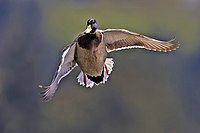Bird flu spreading through Indonesia and China
Thursday, February 9, 2006
Two Indonesian women, 23 and 27, have tested positive for the H5N1 strain of avian influenza. They are in "serious condition but seem to be improving," said Hariadi Wibisono, a senior health ministry official. They are being treated in the designated bird flu hospital, Sulianti Suroso in eastern Jakarta. It is believed that both women had contact with infected poultry. This brings Indonesia's number of confirmed cases of the virus to 25.
A 26 year old female farmer in Fujian, China whose surname is Lin, also has the deadly H5N1 virus. She was admitted to the hospital in January, but it was only confirmed on Wednesday that she had the virus. Some of the people that have come in close contact with the woman are under observation by local health officials. Her current condition is reported as stable. This is China's eleventh confirmed case of the virus.
Julie Hall of the Beijing-based World Health Organization said that the latest patient was "highly likely to have had contact with sick animals," but the WHO is still waiting for information on how she could have gotten the disease.
Some experts believe migrating birds from China's Qinghai Lake nature reserve are spreading the virus; however, there others who believe it's shipments of poultry and poultry products along with poultry manure.
As avian influenza confirmed in Nigeria, "We shouldn't assume that is just in Nigeria" said David Nabarro, the United Nations' coordinator for bird flu and pandemic influenza. "The outbreak in Nigeria means [we] have another central point for the virus to become embedded into the poultry population."
About 20 countries have reported outbreaks of the virus in birds which has sickened people who come in contact with the infected birds. If the rate of human infection continues to increase, so does the chance the virus will change into a form easily transmitted by humans.
Sources
edit- "Two women confirmed with bird flu in Indonesia" — IOL, February 9, 2006
- "China investigates 11th human case of bird flu" — Forbes.com, February 9, 2006
- "Woman contracts bird flu in China" — BBC News, Februaru 9, 2006
- Jason Gale & Allen T. Cheng. "Indonesia, China Find More Human Bird Flu Cases; Virus Spreads" — Bloomberg.com, February 9, 2006
- Helen Branswell. "Deadly bird flu strain found in Nigeria, first case in Africa" — Canada.com, February 8, 2006
- "Avian influenza confirmed in birds in Nigeria" — who, February 8, 2006
